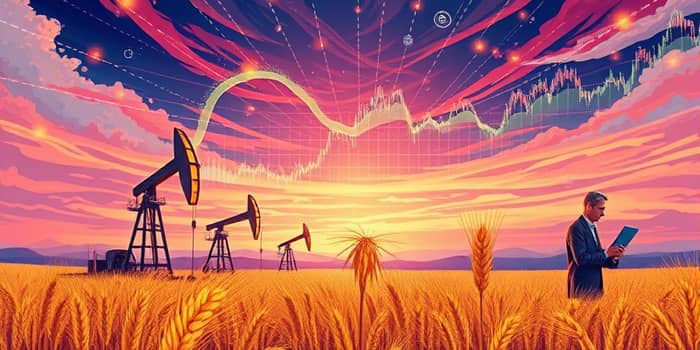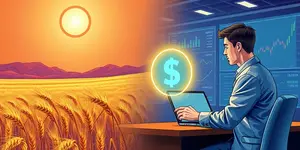Commodities trading sits at the heart of the global economy, shaping the lives of producers, consumers, and investors.
From the oil-rich deserts of the Middle East to the coffee plantations of Latin America, raw materials underpin every industry. This article offers a comprehensive exploration of this dynamic market, combining historical context, current trends, and actionable strategies for success.
Understanding Commodities and Market Structure
Commodities are classified into two broad categories: hard commodities mined or extracted and soft commodities grown or harvested. Hard commodities include energy resources like oil and natural gas, as well as metals such as gold, silver, and copper. Soft commodities encompass agricultural products like wheat, coffee, and soybeans. Each category presents unique supply characteristics, price drivers, and risk profiles.
The global market consists of diverse participants, including:
- Extractors and producers (e.g., oil wells, mines)
- Manufacturers and processors
- Shippers and logistics providers
- Banks, financiers, and speculators
- Hedgers such as institutional investors and commercial users
Seasoned traders leverage advanced risk management and hedging techniques to navigate complex price movements, ensuring liquidity and stability in turbulent times.
Key Trends and 2025 Market Outlook
After unprecedented price surges in recent years, the commodity landscape is poised for adjustment. Analysts forecast a 5% decline in overall commodity prices in 2025, followed by a further 2% drop in 2026, marking the lowest levels in six years. This shift reflects slowing consumption, robust supply chains, and evolving energy transitions.
Aggregate volatility remains a defining feature, with global commodity price volatility at its peak in half a century. The unpredictable swings contribute to inflation uncertainty and economic stress.
In the oil sector, Brent crude is expected to average $73 per barrel, with West Texas Intermediate (WTI) potentially sliding to $64 per barrel. Conversely, precious metals like gold and silver—having reached highs of $2,790 and $35 per ounce in 2024—may continue to rally as safe-haven assets amid lingering macroeconomic risks.
Agricultural and industrial metal prices are forecast to be relatively stable, yet more than half of tracked commodities could decline by over 10% in 2025.
Major Risks and Regulatory Landscape
Commodities trading is inherently risky, shaped by a spectrum of factors ranging from economic fundamentals to regulatory edicts. Key risks include:
- Macroeconomic downturns and tightening financial conditions
- Geopolitical shocks such as conflicts or sanctions
- Supply chain disruptions caused by climate events and logistical bottlenecks
- Regulatory shifts in tariffs, export controls, and sustainability mandates
- Currency fluctuations, particularly the strength of the US dollar
Regulatory compliance and rigorous oversight are critical. Market participants operate under frameworks enforced by bodies like the CFTC, SEC, IIROC, MiFID II, and FINRA. Firms must implement comprehensive AML programs, screen counterparties against sanction lists, and ensure transparent trade reporting. The rise of ESG mandates further elevates the need for detailed sustainability disclosures and environmental, social, and governance initiatives.
Technological Evolution and Opportunities
The digital revolution is transforming every facet of commodities trading. Traders and compliance officers are adopting cutting-edge AI and blockchain systems to enhance transparency, efficiency, and security.
AI-driven analytics provide real-time insights into market sentiment, price anomalies, and potential compliance breaches. Blockchain pilots are streamlining supply chain provenance, enabling immutable records from mine to market. These innovations reduce operational costs, accelerate settlement processes, and improve auditability.
Furthermore, the push for sustainable commodities creates low-carbon and sustainable commodity trading platforms, pairing environmental responsibility with financial performance. Carbon credits and renewable energy certificates are becoming integral to portfolio diversification.
Strategies for Success in Raw Materials Trading
To thrive in this complex environment, traders must blend technical expertise with strategic foresight. Practical steps include:
- Developing a robust risk management framework that incorporates margin requirements, stop-loss orders, and scenario analysis
- Leveraging diversified hedging instruments such as futures, options, and swaps to mitigate price exposure
- Investing in advanced technology for trade surveillance, automated compliance checks, and data-driven decision making
- Building agile operations with real-time monitoring of supply chain events, geopolitical news, and climate risks
At the heart of every successful strategy lies a robust and adaptive trading mindset, one that balances caution with opportunistic positioning. Continual education, scenario planning, and cross-functional collaboration can unlock long-term strategic growth opportunities even amid volatility.
Future Outlook: Charting a Sustainable Path Forward
Looking ahead, the commodities market will evolve in response to technological breakthroughs, regulatory reforms, and societal priorities. The convergence of data analytics, AI, and ESG principles heralds a new era in which transparency and sustainability are not optional but imperative.
Traders who embrace innovation will lead the charge in pioneering transformation through digital and green solutions. By integrating automation, forging strategic partnerships, and adhering to best-in-class compliance standards, market participants can position themselves at the forefront of this dynamic sector.
Ultimately, success in raw materials trading demands resilience, adaptability, and a forward-thinking vision. With informed perspectives and proactive strategies, stakeholders can navigate uncertainties and capitalize on the vast potential of the commodities market, fostering sustainable growth and positive impact for people and planet.
References
- https://brainworksinc.com/commodities-market-experienced-traders-2025/
- https://www.bitedata.io/post/commodity-futures-trading-compliance
- https://openknowledge.worldbank.org/entities/publication/02d005ef-e3d9-44f5-aada-8ba42663a743
- https://redstonesearch.com/how-regulatory-compliance-impacts-commodity-trading-careers/
- https://www.steel-eye.com/industry-commodity-trading-firm
- https://tradingeconomics.com/forecast/commodity










